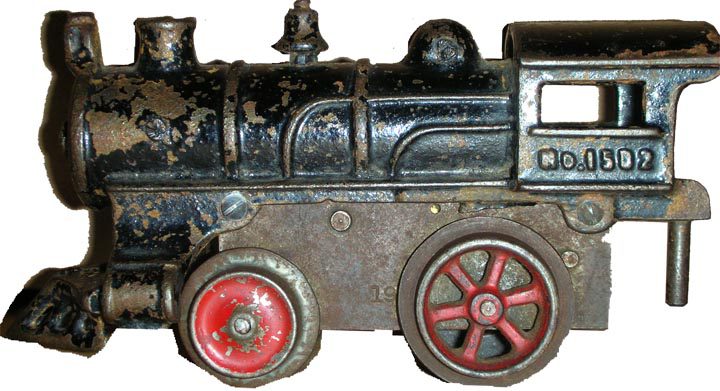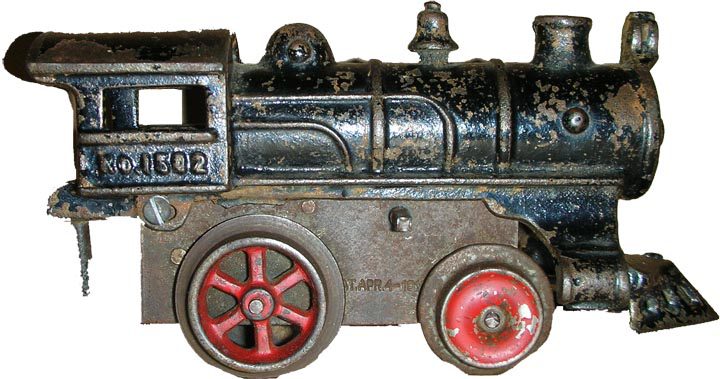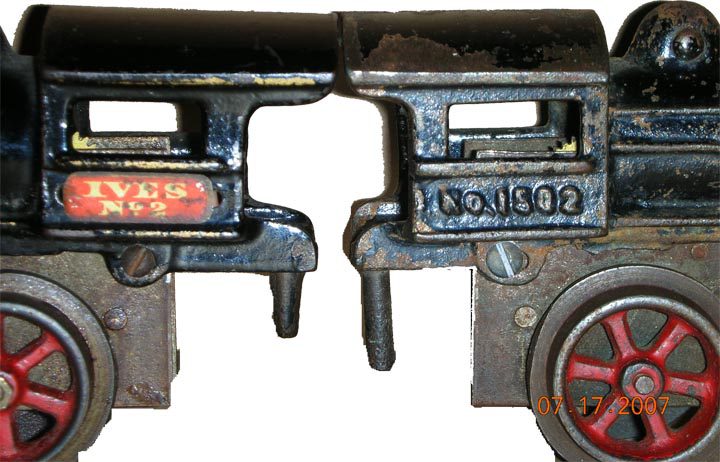Cast Iron Variants
By Jerry Loman
Cast iron wind up train locomotive variants never seems to end on eBay. As I am an avid eBayer of cast iron wind up trains and litho cars, my quest to find the ultimate collectable train never seems to let me down. This never ending stream of auction oddities has made me think that there is no such thing as a concise list of what was produced for the toy train hungry public.
There are numerous published references to the types and variations of the many manufacturers of toy trains. Their respective histories and values to guide you through the endless verities of toy train items are of great help. Having seen or reviewed most that have been published, I still seem to find that unpublished item that adds or distracts to the historical coronagraph.
I am always ready to scrutinize that latest find to determine its age and relative scarcity in respect to the manufacturer or manufacturing place and date. This brings me to the latest item I was lucky enough to scrounge from the eBay portals.
As I am not sure exactly who the manufacturer is, I can at least determine the age of this item by the inconspicuous date stamp that is partially hidden by the wheel as stamped on the motor side frame.
This is very similar to the Ives number 2 (022) loco of 1912 in overall length and proportionate spacing. The Cow catcher, headlight, smoke stack, bell, steam dome, and cab all have dimensional aspects that remain constant to each other.
I would stop there but this casting has some striking dimensional features and sizing not found elsewhere. It does in fact have cast in boiler bands and boiler piping not found on this casting type of Ives. The first Ives cast iron wind up engine from 1902 had the cast in boiler bands but these were striped from the patterns after the first year’s production and all production documents and examples after had showed the bright tin boiler band ornamentation. The more unusual definition was the peculiar 4 numbers under the cab window (####). These numbers were much smaller in size than the numbers that were lithoed or rubber stamped on other Ives locos.
Had this been made as a prototype? Or is this a failed attempt to produce a casting with cast in numbers for the wind up line and the small detail too much for the process to be considered for production intent. Ives was successful in using the cast in numbers below the cab windows of some their floor train models but they were twice the size. Ives also was using numbers and letters on the inside of the castings for pattern numbering but these letters and numbers were much larger than those exhibited on this engine.
Or is this one of the designs that the American Miniature Railroad considered for their production? The American Miniature Railroad company was started by ex-employees of the Ives Company and may have had the model or tool maker expertise to add the additional ornamentation. AMR had successfully added similar detail to the cab window transoms of their locos with the AMRR spaced and sized much like this latest example. The bordering was also similar in size and spacing. The 1912 dating on the motor frame would have been roughly during the demise of the AMR company and having the casting expertise they had shown on the other items they produced it could conceivably be from their line.
The numbers do not appear to coincide with other Ives loco numbering schemes and I do not recognize the number from other train lines. Either way it is exciting to be able to once again find something that can be added to the story of cast iron wind up train development.
Thanks to eBay the fun never ends.
If you have any information on this variation or other items with the cast in numbers below the window please let me know so I can chronicle it for others to reference.









